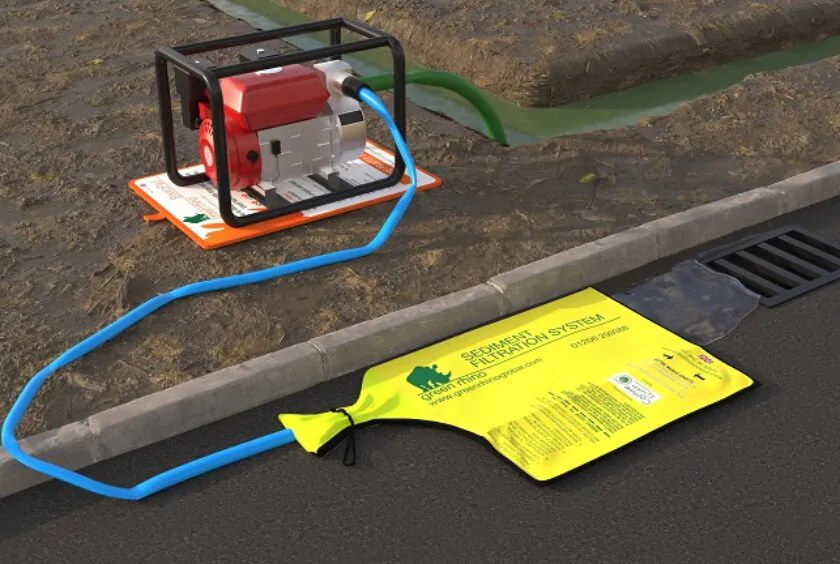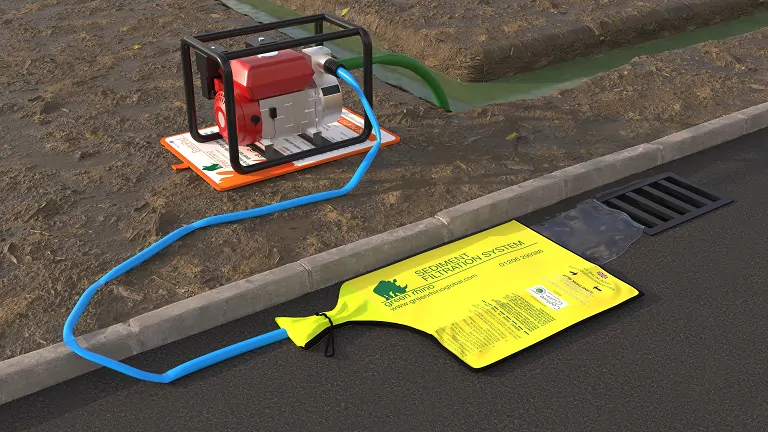Sediment Control on Construction Sites

What is sediment control?
Construction sites can be a major source of sediment-laden run off which can lead to pollution of local waterbodies – either directly or via the surface water drainage system. Sediment control refers to the range of strategies used to minimise this risk to the environment.
The effects of sediment on the environment include:
- Water quality degradation: Sediment carries pollutants like heavy metals, chemicals, and bacteria, which can contaminate water bodies, affecting aquatic life and making the water unsafe for human use.
- Habitat destruction: Excessive sediment can smother and destroy aquatic habitats, disrupting the balance of ecosystems and harming fish and other aquatic species.
- Increased flooding risks: Accumulated sediment can reduce the capacity of stormwater drainage systems, leading to increased flood risks during heavy rainfall.
Causes of sediment on construction sites
Excavation and earthmoving
During excavation activities, the soil is disturbed, leading to the loosening of sediment particles, which can easily erode and run off the site during rain events.
Dewatering
Linked to the above, excavations can fill with groundwater or rainwater which needs to be pumped out. This muddy water needs to be filtered or settled before discharging into the environment.
Lack of ground cover
An early stage of preparing a construction site is the removal of ground cover. This exposes the soil to erosive forces such as wind and water, increasing the likelihood of sediment runoff
Bad weather
Heavy rainfall or storms can exacerbate sediment runoff by carrying loose soil and construction debris into nearby water bodies.
Construction material stockpiles
Piles of construction materials, like sand, gravel, or soil, can be sources of sediment when left exposed to rain or wind.
Strategies for effective sediment control on construction sites
So how do you reduce sediment runoff on construction sites?
Effective sediment control on construction sites involves a four-stage approach:
- Identify the risks and formulate a sediment control plan
- Implement sediment control strategies
- Educate and empower site workers
- Regular site inspections
Sediment control plan
Conduct a comprehensive survey that identifies the sediment run-off risks on your site. Develop a plan that includes relevant erosion and sediment control measures, a training program for site workers and an inspection schedule.
Sediment control approaches fall into three main categories:
- Barriers/stabilisation
- Settlement
- Filtration
Stabilisation practices
Use erosion control blankets, mulching, or hydromulching to stabilise exposed soil surfaces, particularly on slopes, and minimize erosion. Erosion control mats or blankets are usually made from biodegradable materials.
Vegetation and ground cover
Plant native vegetation or use temporary ground cover like straw or erosion control mats to protect bare soil from erosion.
Diversion channels
Implement diversion channels to redirect and control stormwater flow away from vulnerable areas.
Sediment basins and sediment traps
These prefabricated structures are designed to capture sediment runoff and allow settling before the water is discharged.
Silt fences
These temporary fences are made of geotextile fabric and are effective in trapping sediment-laden water.
Straw wattles and sediment control logs
Straw wattles are tube-like structures filled with straw that can be placed along slopes or around construction sites to trap sediment as runoff passes through.
Dewatering Filters and Settlement tanks
When pumping muddy water out of flooded excavations, use sediment filters to clean the water before discharge.

When the filters are full, they can be emptied and reused. Captured sediment can be used to refill excavations. Where dewatering operations are high volume and continuous, settlement tanks offer greater throughout and additional functions such as flocculation. Sediment filters and settlement tanks will reduce the sediment content of the water enough for it to be discharged into the environment.
Drain Filters
To prevent sediment-laden run off entering the stormwater drainage system, drain filters can be fitted inside each gully pot. On housebuilding sites, in particular, where the road and drainage system is built early on, can create a huge volume of muddy water over a long period.
Regular site inspections
Regularly inspect the site to identify erosion and sediment control issues to ensure that your overall strategy is working. Identify weaknesses and address them promptly.
Educate construction workers about the environmental impact
Run training sessions for site workers to explain the risks of sediment to the environment and the strategies being employed on site to minimise this risk. Engaged employees will be able to understand what is happening on site, won’t unwittingly destroy or remove structural elements or filtration products and may help spot any breakdown in prevention.
How Green Rhino can help
Green Rhino manufactures a range of rugged dewatering filters and drain filters. Invite us on site to demonstrate how our filters work and when the different types should be used. We can also show you how to easily check for hydrocarbon contamination before you dewater.
You might also be interested in our Best Practice Guide to Dewatering Excavations.
Summary
It is essential for construction site managers and contractors to implement comprehensive sediment control strategies to mitigate environmental impacts and comply with regulations.
This article has outlined a range of actions and approaches that are commonly used but in all cases you must assess the specific risks on your site and develop an appropriate strategy. If you do this successfully and continue to monitor the effectiveness of your chosen measures then you should avoid harming the environment, damaging drainage systems and incurring penalties.
For further reading, we recommend the following:
Dealing with silty water from construction sites (Netregs)
Temporary Dewatering from Excavations to Surface Water (UK Environment Agency)
